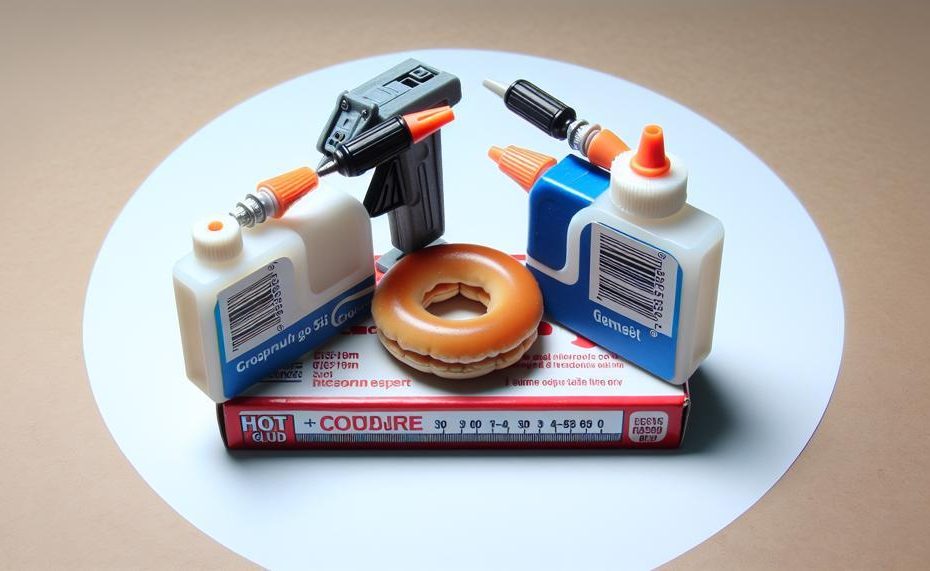Are you tired of constantly reapplying weak adhesives? They just can’t withstand your heavy-duty projects. Say goodbye to frustration and hello to the ultimate bonding solution – hot glue.
This versatile adhesive is readily available in most craft stores. It has become a go-to for many DIY enthusiasts. But did you know that its strength goes beyond just sticking paper and fabric together?
In this blog post, we’ll take a deep dive into the world of hot glue. We’ll discover its impressive weight-bearing capabilities.
Get ready to be blown away by its power as we explore:
- The fundamentals of hot glue and how it sets itself apart from other adhesives
- The key factors that contribute to its remarkable strength
- Real-life examples showcasing hot glue’s ability to tackle heavy-duty projects
- Pro tips for maximizing the strength of your hot glue bonds
- Debunking common misconceptions surrounding hot glue’s holding power
Prepare to be amazed by this seemingly simple yet mighty adhesive. Let’s embark on our journey into the strength of hot glue.
Table of Contents
- 1 What is the weight capacity of hot glue?
- 2 What is the Maximum Weight Hot Glue Can Securely Hold?
- 3 How to Test the Strength of Hot Glue
- 4 Considerations Before Applying Hot Glue
- 5 Tips for Applying Hot Glue Successfully
- 6 What Surfaces are Best Suited for Hot Glue?
- 7 Techniques for Increasing the Strength of Hot Glue
- 8 Safety Precautions for Working with Hot Glue
- 9 Conclusion
What is the weight capacity of hot glue?
When it comes to strength and weight capacity, hot glue may not be the top contender among all adhesives. However, it offers several unique advantages. This makes it a popular choice for everyday use and light-duty applications.
Hot glue’s weight capacity is often underestimated. It is compared to other industrial adhesives such as epoxy and construction adhesive. But do not be fooled by its seemingly low weight capacity of up to 10 pounds. This versatile and easily accessible adhesive has a strength that goes beyond numbers. Its maximum weight-bearing capacity may be lower than others, but its ability to bond to various materials and withstand extreme temperatures makes it a reliable choice for a wide range of projects.
Hot glue’s strength also depends on various factors. These include surface materials and weight distribution. Its weight capacity may be limited to 10 pounds. However, it can hold more if distributed evenly over a larger surface area.
Moreover, hot glue offers several advantages over other types of adhesives. It has a fast curing time, making it ideal for quick fixes and last-minute projects. It can bond to a variety of materials, including fabric, wood, plastic, and metal. This makes it a versatile option for various DIY projects.
Hot glue is resistant to extreme temperatures. This makes it suitable for both indoor and outdoor use.
What is the Maximum Weight Hot Glue Can Securely Hold?
When it comes to determining the maximum weight that hot glue can securely hold, there are various factors that must be taken into account.
These factors include the type of materials being bonded, the thickness and surface area of the bond, and the method of application.
Each of these elements plays a crucial role in determining the weight capacity of hot glue.
Materials:
Typically, hot glue is used for bonding lightweight materials such as paper, fabric, and lightweight plastics.
However, it is not suitable for heavy or load-bearing materials like metal or wood. This is because hot glue is not as strong as other adhesives designed for heavy-duty applications.
Thickness and Surface Area:
The thickness of the bond created by hot glue can also impact its weight capacity. A thicker bond has more surface area. This allows for greater contact between the materials and the adhesive. This can increase the weight capacity of hot glue.
However, if the bond is too thick, it may result in a weaker hold due to air pockets.
Method of Application:
The method of applying hot glue can also affect its weight capacity.
For instance, using a small amount of hot glue on a large surface area may result in a weaker bond. Compared to that, using a larger amount of hot glue on a smaller surface area can create a stronger bond.
Maximum Weight Capacity:
While there is no specific maximum weight capacity for hot glue, it can vary greatly depending on the factors mentioned above. On average, hot glue can securely hold weights between 0 to pounds.
It is always best to test the weight capacity of hot glue on a small sample before using it for larger projects.
Here is a table showing the average maximum weight capacity of different types of hot glue. This will help you understand it better.
| Type of Hot Glue | Average Maximum Weight Capacity (pounds) |
| Low-Temperature Hot Glue | 0-5 |
| High-Temperature Hot Glue | 5-15 |
| Multi-Temperature Hot Glue | 10-20 |
| Industrial Hot Glue | 20+ |
These are just rough estimates. The actual weight capacity may vary. This depends on the specific brand and application method.
Always follow the manufacturer’s instructions. Test the weight capacity before using hot glue for any weight-bearing projects.
How to Test the Strength of Hot Glue
There are three primary techniques for assessing the strength of hot glue at home: the pull test, shear test, and tension test.
Each method offers a unique way to measure the bond’s durability and requires different materials to perform.
| Method | Description | Materials Needed |
| Pull Test | Gradually increase weight on the bonded object until the bond breaks. | Hot glue gun, heat-resistant surface, two objects to be glued together, weight scale, weights of varying sizes. |
| Shear Test | Apply force parallel to the bond to see how much weight it can withstand. | Hot glue gun, heat-resistant surface, two objects to be glued together, weight scale, clamp or vise. |
| Tension Test | Pull the bond apart in opposite directions to see how much weight it can withstand. | Hot glue gun, heat-resistant surface, two objects to be glued together, weight scale, clamps or weights. |
To conduct these tests at home, you will need: a hot glue gun, a heat-resistant surface, two objects to be bonded (such as wood or plastic), a weight scale, and additional materials specific to each test. It is crucial to properly prepare your work area and allow the glue to dry completely before testing. Keep in mind that elements like temperature and humidity can impact the test results.
In conclusion, although hot glue may not be suitable for heavy-duty applications, it is still a dependable adhesive for everyday use and moderate stress.
Considerations Before Applying Hot Glue
Before starting any project that requires hot glue, there are several factors to take into consideration. These considerations can greatly affect the weight that hot glue can hold on fabric and ensure a successful and long-lasting bond. In this section, we will explore the various factors that should be kept in mind before applying hot glue.
The type of fabric being used is an essential factor to consider when working with hot glue. Different fabrics have different levels of durability and tensile strength. This can affect how well the hot glue will bond. For instance, delicate fabrics like silk may not have the same weight holding capacity as sturdier fabrics like denim. Therefore, it is crucial to choose the right type of fabric for your project. This will help you achieve the desired results.
Another factor that can affect the weight holding capacity of hot glue is the temperature at which it is applied. It is crucial to carefully adjust the temperature of the hot glue. This ensures a strong bond without damaging the fabric. If the glue is too hot, it may burn or weaken the fabric, reducing its weight holding capacity. On the other hand, if it is not hot enough, it may not create a strong enough bond to hold heavier objects.
The amount of pressure applied when attaching materials together is also a crucial factor to consider for a secure and long-lasting bond. The right amount of pressure must be applied to ensure that the bond created by the hot glue is strong enough to hold heavier objects. If there is not enough pressure, the bond may not be strong enough and could result in objects falling apart.
While hot glue is an excellent adhesive option for many projects, it may not always be suitable for every situation. Each project has specific needs and preferences. Consider alternative options such as fabric glue or stitching.
Fabric glue may be better for delicate fabrics, while stitching can provide a stronger bond for heavy objects.
Tips for Applying Hot Glue Successfully
When it comes to using hot glue, there are several key tips that can help you achieve successful results. These tips include: cleaning the surfaces, using the right amount of glue, applying pressure while it cools, considering a high-temperature hot glue gun, and using quality hot glue sticks.
By following these tips, you can ensure a strong bond between the surfaces and the glue. You can also increase the weight capacity of the hot glue.
To make sure your hot glue bonds are strong and able to withstand various weights, it is important to clean the surfaces before gluing. This ensures maximum bond strength. It removes any debris or residue that may weaken the bond.
Additionally, it is crucial to apply enough glue to cover 80% of the surface area. This is important for achieving a strong bond and preventing weak spots that may fail under weight.
Another tip for successful hot glue application is to apply pressure while the glue cools. This increases contact between the surfaces and the glue, resulting in a stronger bond and increased weight capacity. Furthermore, considering a high-temperature hot glue gun can also contribute to a stronger bond. Melting the glue at a higher temperature results in increased strength and weight capacity.
Lastly, using quality hot glue sticks is essential for achieving successful results with hot glue. High-quality hot glue sticks have stronger bonding properties. This results in a stronger bond and increased weight capacity.
It is important to note that the weight-bearing capacity of hot glue also depends on other factors. These include surface materials and the distribution of weight.
What Surfaces are Best Suited for Hot Glue?
Hot glue is a versatile adhesive that can be used on a wide range of surfaces. However, certain types of surfaces will result in a stronger bond and higher weight capacity. These surfaces include:
- Porous materials: Hot glue is most effective on porous surfaces, such as paper, fabric, and wood. The porous texture allows the glue to seep into the material, creating a stronger bond.
- Roughened surfaces: For smooth surfaces like plastic or metal, it is crucial to roughen the surface slightly before applying hot glue. This can be achieved by using sandpaper or lightly scratching the surface with a knife.
- Lightweight materials: Hot glue is an excellent choice for lightweight materials like paper, fabric, and lightweight wood. However, it should not be used on heavy materials or those under pressure as it may result in a weak bond.
- Non-porous materials: While hot glue can be used on non-porous materials like plastic and metal, it may not create a strong bond. Hence, it is best to use hot glue on these surfaces for decorative purposes rather than practical use.
- Temperature-sensitive materials: It is important to avoid using hot glue on extreme temperatures as it can affect its bonding strength. Therefore, it is best to refrain from using hot glue on materials that will be exposed to heat or cold.
In conclusion, while hot glue can be used on a variety of surfaces, it is most suitable for porous and slightly roughened surfaces, lightweight materials, and non-porous materials for decorative purposes.
Techniques for Increasing the Strength of Hot Glue
There are several tried and tested techniques for increasing the strength of hot glue. You can use them. These methods include roughening the surface. They also involve using a primer and applying heat to the bond.
Each of these methods has its own unique benefits and can greatly improve the strength of your hot glue bonds. Let’s explore each method in more detail:
Roughen the Surface:
One effective way to increase the strength of hot glue is by roughening up the surface before gluing. By creating a rough surface, you are providing more area for the glue to adhere to, resulting in a stronger bond.
You can easily achieve this by using sandpaper or a file to gently roughen up the surface before applying the hot glue.
Use a Primer:
Another useful technique for increasing hot glue strength is by using a primer.
A primer is a special type of adhesive that helps the hot glue bond better with the surface. Simply apply the primer to the surface before using hot glue, and you’ll notice a significant improvement in bond strength.
Apply Heat:
Applying heat to the bond is yet another effective technique for increasing hot glue strength.
This can be done by using a hair dryer or heat gun to warm up the bond for a few seconds. However, be careful not to overheat the surface as this could damage it or cause the bond to break.
Choosing the Right Type of Hot Glue:
In addition to these techniques, it is crucial to choose the right type of hot glue for your project. Different types of hot glue have varying strengths and are designed for different purposes.
By selecting the appropriate type of hot glue and implementing these techniques, you can significantly increase the strength of your hot glue bonds.
Safety Precautions for Working with Hot Glue
Safety Precautions for Working with Hot Glue:
Use Appropriate Protective Equipment:
Hot glue can cause serious burns if not handled carefully. To protect yourself, make sure to wear gloves, eye protection, and long-sleeved clothing when working with hot glue.
Select the Correct Type of Glue Gun:
Different types of glue guns are suitable for different projects. Make sure to choose the right one for your project to avoid accidents and injuries.

For example, a low-temperature glue gun is ideal for crafts and DIY projects. A high-temperature glue gun is better for heavy-duty projects.
Follow Safety Guidelines:
Always read and follow the safety guidelines provided with your glue gun. This will ensure that you are using it correctly and safely.
Remember to unplug the gun when not in use. Never leave it unattended. Keep it out of reach from children.
Use Heat-Resistant Surfaces:
To prevent fire hazards, always work on a heat-resistant surface when using hot glue.
A silicone mat or aluminum foil can serve as a protective surface.
Handle Hot Glue with Caution:
Hot glue can reach temperatures up to 400 degrees Fahrenheit. If not handled carefully, it can cause severe burns.
Avoid touching the nozzle or any hot glue that has dripped onto your work surface.
Know How to Treat Burns:
Despite taking precautions, accidents can still happen when working with hot glue.
In case of a burn, immediately cool the affected area with cold water and cover it with a sterile bandage. Seek medical attention if necessary.
Also Read: Is Hot Glue Toxic?
Conclusion
In conclusion, hot glue may seem simple, but it’s a versatile and powerful tool for DIY enthusiasts.
Its strength goes beyond just sticking paper and fabric together. It has an impressive weight-bearing capacity of up to 10 pounds. But its true power lies in its ability to bond to various materials. It can also withstand extreme temperatures.
Master the fundamentals of hot glue. Incorporate pro tips to maximize its strength. This allows you to confidently take on heavy-duty projects. You won’t have to constantly reapply weak adhesives.
Say goodbye to frustration and hello to the ultimate bonding solution – hot glue.






